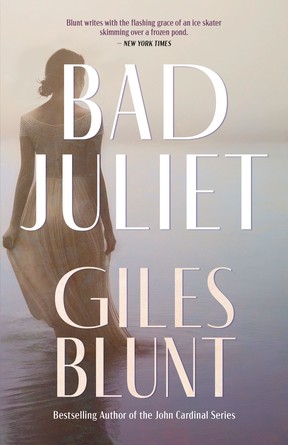Canadian author Giles Blunt trades thrillers for chilling love story

Article content
Reviews and recommendations are unbiased and products are independently selected. Postmedia may earn an affiliate commission from purchases made through links on this page.
Novelists who deliver a profound sense of place in their writings are worth their weight in gold.
Take Giles Blunt, for example. His lauded John Cardinal thrillers were compelling studies in character about the personal and professional crises facing a dedicated northern Ontario cop as he struggled to navigate his way through a dangerously imperfect world. However, they were also anchored to a vividly realized landscape, black flies and all, drawn from Blunt’s own North Bay childhood.
Indeed, it was a wintry return visit as an adult that led to Blunt’s first Cardinal novel, Forty Words For Sorrow. He was walking along the shores of Lake Nipissing during a near whiteout. “You could just see the faint outline of this little island with an abandoned mine shaft on it, and I thought — what an eerie place to find a body.” With that thought he was on his way as a top-selling novelist.
Years later, Blunt is still talking about the importance of place in his creative imagination, only this time it’s somewhere quite different — in this case New York State’s mountainous Adirondack region and more specifically the community of Saranac Lake as it existed more than a century ago.
It’s the setting for his latest novel, Bad Juliet, a doom-haunted story of obsessive love, and if it sometimes takes on the aura of a fevered dream — well, this is the sort of period setting that invites it and compels one to read on.

Giles Blunt
Dundurn
The village began casting a spell over Blunt and his wife the first time they visited it several years ago. “I couldn’t wait to set a story there,” he says now.
Saranac Lake was once a renowned centre for the treatment of tuberculosis — so renowned, in fact, that when its original sanatorium could no longer meet patient needs, the entire area would evolve into a “sanatorium” with local residents turning their homes into “cure cottages” overseen by doctors, nurses, and public health agencies.
“I was just fascinated by the history,” Blunt tells Postmedia from his Toronto home. In the strange story he has to tell, he reveals a Saranac Lake so economically stable that it can support gourmet restaurants and live theatre. Blunt can still feel the past reaching out whenever he visits.
“Private citizens had modified houses to accommodate patients — for example adding portions so patients could sit inside in the dry healthy air. You can visit today and the modified houses are still there — what an amazing thing.”
It’s to this place, in the midst of a TB epidemic that is killing 90,000 Americans a year that the book’s central figure, a failed young academic named Paul Gascoyne, comes to to eke out a living tutoring patients in literature and the craft of writing while nursing his grievances over his treatment by the wider world. His encounter with Sarah, a mysterious young woman who escaped death during the sinking of the Lusitania only to be facing mortality again through illness, draws him into an emotional drama for which he is ill prepared.
Bad Juliet constitutes a marked departure from the crime-ridden world of the John Cardinal books which were also to inspire a successful CTV television series. So why did Blunt change gears?
“Basically, none of the crime ideas I was coming up with left me desiring to write,” he says pragmatically. “It was as simple as that. Crime fiction stopped speaking a particular language to me. I had to move onto something else.”
He was also moving away from the gritty violence of the John Cardinal novels, but in some ways Bad Juliet shares their sensibility. There was once more the importance of setting but also the continuing appeal for Blunt of “placing a set of characters in a fairly particular circumstance, bringing them into conflict and causing them heartache.”
Furthermore, although a literary novel, Bad Juliet is still driven by an element of tantalizing mystery surrounding the character of Sarah who is traumatized by the tragedy of the Lusitania — a disaster vividly recreated in this book — yet a continuing enigma to Paul who, in seeking to help her come to terms with a troubled past, is becoming infatuated with her. How trustworthy are her accounts of her personal history? Are her fractured childhood memories really reliable? Will he ever know who she really is? These questions begin to unnerve him.
“I want this to be a novel that readers can kind of dissolve into — and feel themselves drawn into this world and characters, with enough surprise and tension to keep them fascinated.”
Blunt was attracted to the idea of writing about someone with this degree of ambiguity and mystery. But along with the psychological suspense, there was the need to write a novel of character. The novel comes to the reader as a first-person narrative — that of an aging Paul ruefully looking back over the decades to events that would shape him forever.
“We learn more and more about Sarah toward the end of the book and more about Paul as he learns more about himself,” Blunt says. “What’s he going to do about Sarah? How’s he going to handle the things that he’s learning?
“I want this to be a novel that readers can kind of dissolve into — and feel themselves drawn into this world and characters, with enough surprise and tension to keep them fascinated.”
Meanwhile, Blunt himself remains fascinated by the enigmatic allure of Sarah. “One character in the book refers to the ‘glamour’ of tragedy. She has that air.”












Postmedia is committed to maintaining a lively but civil forum for discussion. Please keep comments relevant and respectful. Comments may take up to an hour to appear on the site. You will receive an email if there is a reply to your comment, an update to a thread you follow or if a user you follow comments. Visit our Community Guidelines for more information.